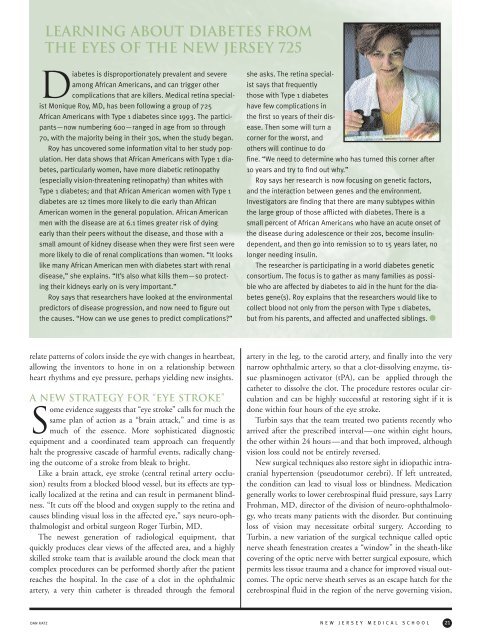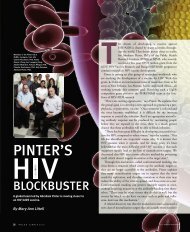changing the course of stroke - New Jersey Medical School ...
changing the course of stroke - New Jersey Medical School ...
changing the course of stroke - New Jersey Medical School ...
Create successful ePaper yourself
Turn your PDF publications into a flip-book with our unique Google optimized e-Paper software.
elate patterns <strong>of</strong> colors inside <strong>the</strong> eye with changes in heartbeat,<br />
allowing <strong>the</strong> inventors to hone in on a relationship between<br />
heart rhythms and eye pressure, perhaps yielding new insights.<br />
A <strong>New</strong> Strategy for “Eye Stroke”<br />
Some evidence suggests that “eye <strong>stroke</strong>” calls for much <strong>the</strong><br />
same plan <strong>of</strong> action as a “brain attack,” and time is as<br />
much <strong>of</strong> <strong>the</strong> essence. More sophisticated diagnostic<br />
equipment and a coordinated team approach can frequently<br />
halt <strong>the</strong> progressive cascade <strong>of</strong> harmful events, radically <strong>changing</strong><br />
<strong>the</strong> outcome <strong>of</strong> a <strong>stroke</strong> from bleak to bright.<br />
Like a brain attack, eye <strong>stroke</strong> (central retinal artery occlusion)<br />
results from a blocked blood vessel, but its effects are typically<br />
localized at <strong>the</strong> retina and can result in permanent blindness.<br />
“It cuts <strong>of</strong>f <strong>the</strong> blood and oxygen supply to <strong>the</strong> retina and<br />
causes blinding visual loss in <strong>the</strong> affected eye,” says neuro-ophthalmologist<br />
and orbital surgeon Roger Turbin, MD.<br />
The newest generation <strong>of</strong> radiological equipment, that<br />
quickly produces clear views <strong>of</strong> <strong>the</strong> affected area, and a highly<br />
skilled <strong>stroke</strong> team that is available around <strong>the</strong> clock mean that<br />
complex procedures can be performed shortly after <strong>the</strong> patient<br />
reaches <strong>the</strong> hospital. In <strong>the</strong> case <strong>of</strong> a clot in <strong>the</strong> ophthalmic<br />
artery, a very thin ca<strong>the</strong>ter is threaded through <strong>the</strong> femoral<br />
DAN KATZ<br />
Learning About Diabetes From<br />
The Eyes <strong>of</strong> The <strong>New</strong> <strong>Jersey</strong> 725<br />
Diabetes is disproportionately prevalent and severe<br />
among African Americans, and can trigger o<strong>the</strong>r<br />
complications that are killers. <strong>Medical</strong> retina specialist<br />
Monique Roy, MD, has been following a group <strong>of</strong> 725<br />
African Americans with Type 1 diabetes since 1993. The participants—now<br />
numbering 600—ranged in age from 10 through<br />
70, with <strong>the</strong> majority being in <strong>the</strong>ir 30s, when <strong>the</strong> study began.<br />
Roy has uncovered some information vital to her study population.<br />
Her data shows that African Americans with Type 1 diabetes,<br />
particularly women, have more diabetic retinopathy<br />
(especially vision-threatening retinopathy) than whites with<br />
Type 1 diabetes; and that African American women with Type 1<br />
diabetes are 12 times more likely to die early than African<br />
American women in <strong>the</strong> general population. African American<br />
men with <strong>the</strong> disease are at 6.1 times greater risk <strong>of</strong> dying<br />
early than <strong>the</strong>ir peers without <strong>the</strong> disease, and those with a<br />
small amount <strong>of</strong> kidney disease when <strong>the</strong>y were first seen were<br />
more likely to die <strong>of</strong> renal complications than women. “It looks<br />
like many African American men with diabetes start with renal<br />
disease,” she explains. “It’s also what kills <strong>the</strong>m—so protecting<br />
<strong>the</strong>ir kidneys early on is very important.”<br />
Roy says that researchers have looked at <strong>the</strong> environmental<br />
predictors <strong>of</strong> disease progression, and now need to figure out<br />
<strong>the</strong> causes. “How can we use genes to predict complications?”<br />
she asks. The retina specialist<br />
says that frequently<br />
those with Type 1 diabetes<br />
have few complications in<br />
<strong>the</strong> first 10 years <strong>of</strong> <strong>the</strong>ir disease.<br />
Then some will turn a<br />
corner for <strong>the</strong> worst, and<br />
o<strong>the</strong>rs will continue to do<br />
fine. “We need to determine who has turned this corner after<br />
10 years and try to find out why.”<br />
Roy says her research is now focusing on genetic factors,<br />
and <strong>the</strong> interaction between genes and <strong>the</strong> environment.<br />
Investigators are finding that <strong>the</strong>re are many subtypes within<br />
<strong>the</strong> large group <strong>of</strong> those afflicted with diabetes. There is a<br />
small percent <strong>of</strong> African Americans who have an acute onset <strong>of</strong><br />
<strong>the</strong> disease during adolescence or <strong>the</strong>ir 20s, become insulindependent,<br />
and <strong>the</strong>n go into remission 10 to 15 years later, no<br />
longer needing insulin.<br />
The researcher is participating in a world diabetes genetic<br />
consortium. The focus is to ga<strong>the</strong>r as many families as possible<br />
who are affected by diabetes to aid in <strong>the</strong> hunt for <strong>the</strong> diabetes<br />
gene(s). Roy explains that <strong>the</strong> researchers would like to<br />
collect blood not only from <strong>the</strong> person with Type 1 diabetes,<br />
but from his parents, and affected and unaffected siblings. ●<br />
artery in <strong>the</strong> leg, to <strong>the</strong> carotid artery, and finally into <strong>the</strong> very<br />
narrow ophthalmic artery, so that a clot-dissolving enzyme, tissue<br />
plasminogen activator (tPA), can be applied through <strong>the</strong><br />
ca<strong>the</strong>ter to dissolve <strong>the</strong> clot. The procedure restores ocular circulation<br />
and can be highly successful at restoring sight if it is<br />
done within four hours <strong>of</strong> <strong>the</strong> eye <strong>stroke</strong>.<br />
Turbin says that <strong>the</strong> team treated two patients recently who<br />
arrived after <strong>the</strong> prescribed interval—one within eight hours,<br />
<strong>the</strong> o<strong>the</strong>r within 24 hours—and that both improved, although<br />
vision loss could not be entirely reversed.<br />
<strong>New</strong> surgical techniques also restore sight in idiopathic intracranial<br />
hypertension (pseudotumor cerebri). If left untreated,<br />
<strong>the</strong> condition can lead to visual loss or blindness. Medication<br />
generally works to lower cerebrospinal fluid pressure, says Larry<br />
Frohman, MD, director <strong>of</strong> <strong>the</strong> division <strong>of</strong> neuro-ophthalmology,<br />
who treats many patients with <strong>the</strong> disorder. But continuing<br />
loss <strong>of</strong> vision may necessitate orbital surgery. According to<br />
Turbin, a new variation <strong>of</strong> <strong>the</strong> surgical technique called optic<br />
nerve sheath fenestration creates a “window” in <strong>the</strong> sheath-like<br />
covering <strong>of</strong> <strong>the</strong> optic nerve with better surgical exposure, which<br />
permits less tissue trauma and a chance for improved visual outcomes.<br />
The optic nerve sheath serves as an escape hatch for <strong>the</strong><br />
cerebrospinal fluid in <strong>the</strong> region <strong>of</strong> <strong>the</strong> nerve governing vision,<br />
NEW JERSEY MEDICAL SCHOOL<br />
21






